v1 measurement with EPD at 19.6 and 27 GeV
Measurement of directed flow in Au+Au collisions at 19.6 and 27 GeV
PAs: Shinichi Esumi (University of Tsukuba), Mike Lisa (OSU), Xiaoyu Liu (OSU), Prithwish Tribedy (BNL)
Link to the latest paper drafts:
https://drupal.star.bnl.gov/STAR/system/files/v1_paper_ver3.pdf
Link to the analysis note:
https://drupal.star.bnl.gov/STAR/starnotes/private/PSN0812
Target Journal: PRC
Abstract:
Directed flow (\vone) describes the collective sideward motion of produced particles and nuclear fragments in heavy-ion collisions. It carries information on the very early stage of the collision, especially at large pseudorapidity ($\eta$), where it is believed to be generated during the nuclear passage time. Directed flow therefore probes the onset of bulk collective dynamics during thermalization, providing valuable experimental guidance to models of the pre-equilibrium stage. In 2018, the Event Plane Detector (EPD, $2.1 <|\eta|< 5.1$) was installed in STAR and used for the Beam Energy Scan phase-II (BES-II) data taking. The combination of EPD and high-statistics BES-II data enables us to extend the \vone\ measurement to the forward and backward $\eta$ regions. In this paper, we present the measurement of $v_{1}$ over a wide $\eta$ range in Au+Au collisions at $\sqrt{s_{NN}}=$ 19.6 and 27 GeV using the STAR EPD. The results of the analysis at \snn\ 19.6 GeV exhibit excellent consistency with the previous PHOBOS measurement, while elevating the precision of the overall measurement to a new level. The increased precision of the measurement also revealed finer structures in heavy-ion collisions, including a potential observation of the first-order event plane decorrelation. Multiple physics models were compared to the analysis results. Only transport model and three-fluid hybrid model can reproduce a sizable \vone\ at large $\eta$ as what was observed experimentally. The model comparison also indicates \vone\ at large $\eta$ might be sensitive to the QGP phase transition.
.png)
(a): a sketch of an event recorded by the TPC and the EPD; Figure 2(b): the pseudorapidity (η) range of a EPD tile depends on the primary vertex position. The EPD acceptance is 2.1<|η|<5.1 when (V_x,V_y,V_z) = (0,0,0).
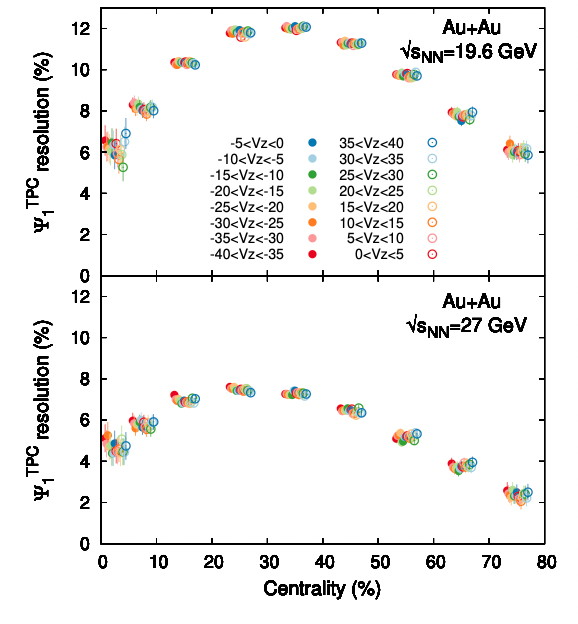
$\Psi_{1}^{\mathrm{TPC}}$ resolution as a function of centrality for 16 $V_{z}$ bins; the resolution is calculated by the three sub event method. The data points are shifted along the x-axis for a clearer presentation.

The calibrated ADC distribution (blue, largely obscured by the red curve). The shaded areas represent the expected energy loss distribution when 1, 2, 3, 4 minimum ionization particles (MIPs) traverse an EPD tile. The histogram was fitted by the weighted sum of these four distributions (red curve) using the weights as the fitting parameters. Figure 3(b): the (ϕ-Ψ_1) distribution. Each point was obtained by fitting multiple calibrated ADC distributions. The leftmost point is calculated from the ADC spectra of 24 tiles on ring 16 including the one shown in (a).
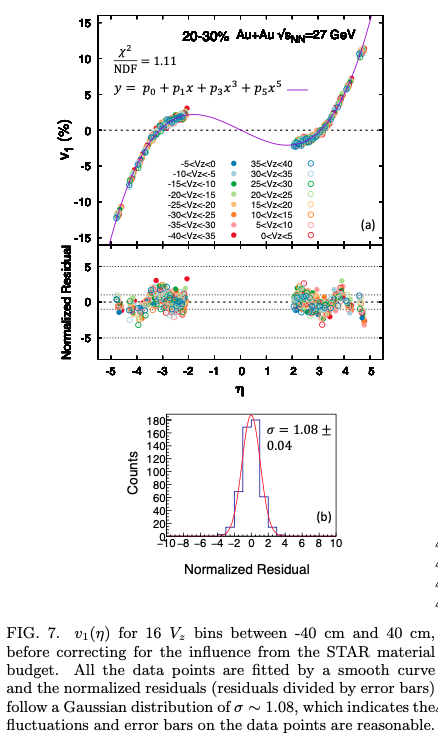


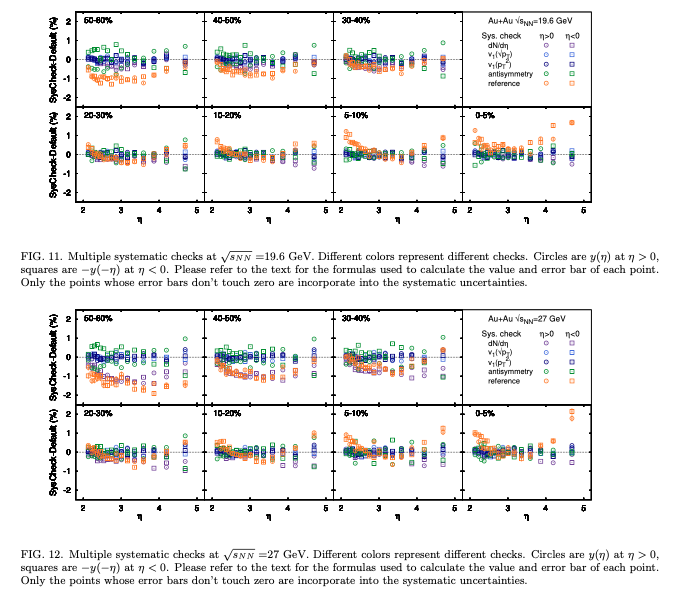

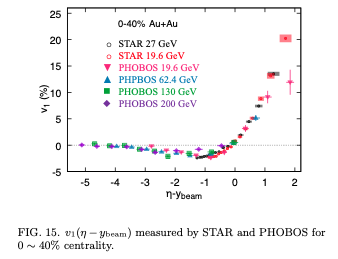
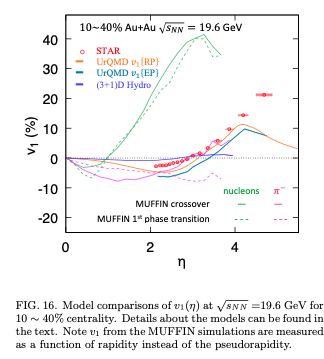
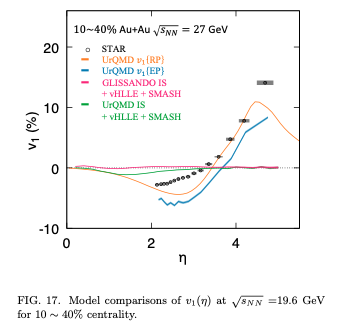
Conclusion:
In this paper, we presented \veta\ measured at \snn\ 19.6 and 27 GeV over six units of $\eta$ using the STAR EPD. In order to use a scintillator detector as the particles of interest region, we developed an entire new method to ensure the accuracy of this measurement. The analysis results at \snn\ 19.6 GeV exhibited excellent consistency with the previous PHOBOS measurement in the same phase space (\vone\ integrated over all $p_{T}$), while elevating the precision to a new level. The increased precision of the measurement also revealed finer structures of the heavy-ion collision, including a potential evidence for the first-order event plane decorrelation. A collision-energy scaling of $v_{1}(\eta-y_{\mathrm{beam}})$ was observed at $(\eta-y_{\mathrm{beam}})>0$ for \snn\ 19.6 and 27 GeV, which indicates the \vone\ at large $|\eta|$ might not only come from the deflection of nuclear fragments. Simulations from various models including transport, hydrodynamic, one-fluid hybrid and three-fluid hybrid models have been compared to this measurement. Only UrQMD (transport model) and MUFFIN (three-fluid hybrid model) were able to reproduce a significant \vone\ at the forward(backward) $\eta$ as observed in the experiment. This underscores the importance of incorporating all segments of the heavy-ion collision in model studies, especially at BES energies where nuclear fragments can substantially influence particle production across the entire pseudorapidity range. The comparison with the MUFFIN simulation indicates \vone\ at large $\eta$ might be sensitive to the QGP phase transition. Furthermore, the UrQMD study has shown significant discrepancy between $v_{1}\{\mathrm{EP}\}$ and $v_{1}\{\mathrm{RP}\}$, demonstrating the importance of employing the same reference when comparing experimental measurements and model calculations.
Previous presentations:
Update in FCV:
- https://drupal.star.bnl.gov/STAR/meetings/STAR-Collaboration-Meeting-September-2022/FCV-Parallel-Session-I/Measurement-directed-flow- (Sep. 13,2022)
- https://drupal.star.bnl.gov/STAR/system/files/FCV_03152022_0.pdf (Mar. 15, 2022)
- https://drupal.star.bnl.gov/STAR/system/files/FCV_03082022.pdf (Mar. 08, 2022)
- https://drupal.star.bnl.gov/STAR/system/files/FCV_10262021.pdf (Oct. 26, 2021)
- https://drupal.star.bnl.gov/STAR/system/files/BulkCorr05052021.pdf(May 05, 2021)
- https://drupal.star.bnl.gov/STAR/system/files/FCV_Feb32021.pdf (Feb. 03, 2021)
- https://drupal.star.bnl.gov/STAR/system/files/BulkCorr_0603_v1_nMIP.pdf (Jun. 03, 2020)
STAR presentations:
- https://drupal.star.bnl.gov/STAR/presentations/Quark-Matter-2023/First-order-event-plane-correlated-v1-and-v3-BES-II-AuAu-collisions- (Sep. 2023, QM)
- https://indico.frib.msu.edu/event/50/contributions/1175/attachments/311/1664/WPCF2022_ver4.pdf (Jul. 19, 2022, QM)
- https://indico.cern.ch/event/895086/contributions/4721343/attachments/2420866/4145762/QM2022_Poster_340_Xiaoyu_Liu_v7.pdf (Apr. 6, 2022, WPCF)
- https://drupal.star.bnl.gov/STAR/system/files/DNP2020_Xiaoyu_slides_v5_0.pdf (Oct. 30, 2020, DNP)
Preliminary results:
https://drupal.star.bnl.gov/STAR/blog/lxy1122/Preliminary-plot-request
Code: $CVSROOT/offline/paper/psn0812
Appendix to the analysis note:
https://drupal.star.bnl.gov/STAR/blog/lxy1122/Appendices-analysis-note-v1-measured-EPD
- lxy1122's blog
- Login or register to post comments
